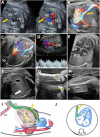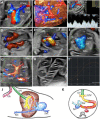Prenatal Diagnosis and Outcome of Umbilical-Portal-Systemic Venous Shunts: Experience of a Tertiary Center and Proposal for a New Complex Type
- PMID: 35453921
- PMCID: PMC9027129
- DOI: 10.3390/diagnostics12040873
Prenatal Diagnosis and Outcome of Umbilical-Portal-Systemic Venous Shunts: Experience of a Tertiary Center and Proposal for a New Complex Type
Abstract
Aims: To share our experience in the prenatal diagnosis of umbilical-portal-systemic venous shunts (UPSVS) and to study the prognostic factors for proper prenatal and perinatal management. Material and Methods: A five-year prospective study regarding the detection of UPSVS was conducted in two referral centers, Medgin Ginecho Clinic and the Prenatal Diagnostic Unit of the tertiary center, University Emergency County Hospital Craiova, Romania. We included in the analysis a series of agenesis of ductus venosus (ADV) cases previously reported by our center. We analyzed the incidence of the UPSVS types, their associations, and outcome predictors. Results: UPSVS were diagnosed in all 16 cases that were presented to our center at the time of first trimester anomaly scan, except one (94.12%). We diagnosed: 19 type I (61.2%), 4 type II (12.9%) and 5 type IIIa (16.1%) UPSVS. In three cases (9.6%) we noted multiple shunts, which we referred to as type IV (a new UPSVS type). Type IIIa-associated fetal growth restriction (FGR) was found in 60% of cases. Major anomalies worsened the outcome. Of the UPVSS cases, 57.1% were associated with PVS anomalies. Genetic anomalies were present in 40% of the tested cases. Conclusions: The incidence of UPSVS in our study was 0.2%. Early detection is feasible. The postnatal outcome mainly depends on the presence of structural, genetic and PVS anomalies. FGR may be associated. The new category presented a poor outcome secondary to poor hemodynamic and major associated anomalies.
Keywords: agenesis of ductus venosus; color Doppler; fetal venous shunt; portal system; prenatal diagnosis; umbilical drainage; umbilical–portal–systemic venous shunt; venous anomalies.
Conflict of interest statement
The authors declare no conflict of interest.
Figures






Similar articles
-
Perinatal outcomes in cases of umbilical-portal-systemic venous shunts: experience of a tertiary center.BMC Pregnancy Childbirth. 2025 Apr 10;25(1):420. doi: 10.1186/s12884-025-07541-z. BMC Pregnancy Childbirth. 2025. PMID: 40211204 Free PMC article.
-
Prenatal sonographic characteristics and postnatal outcomes of umbilical-portal-systemic venous shunts under the new in-utero classification: A retrospective study.Medicine (Baltimore). 2019 Jan;98(2):e14125. doi: 10.1097/MD.0000000000014125. Medicine (Baltimore). 2019. PMID: 30633228 Free PMC article.
-
Fetal umbilical-portal-systemic venous shunt: in-utero classification and clinical significance.Ultrasound Obstet Gynecol. 2016 Jun;47(6):739-47. doi: 10.1002/uog.14906. Ultrasound Obstet Gynecol. 2016. PMID: 25988346
-
Prenatal diagnosis of congenital agenesis of the fetal portal venous system.Ultrasound Obstet Gynecol. 2009 Dec;34(6):643-52. doi: 10.1002/uog.7460. Ultrasound Obstet Gynecol. 2009. PMID: 19953566 Review.
-
Agenesis of the ductus venosus associated with direct umbilical venous return into the heart--case series and review of literature.Prenat Diagn. 2004 Jun;24(6):418-23. doi: 10.1002/pd.882. Prenat Diagn. 2004. PMID: 15229839 Review.
Cited by
-
Prenatal Diagnosis and Prognosis of Abdominal Arteriovenous Fistulae: A Comprehensive Case Series and Systematic Review.Diagnostics (Basel). 2024 Apr 17;14(8):826. doi: 10.3390/diagnostics14080826. Diagnostics (Basel). 2024. PMID: 38667471 Free PMC article.
-
Prenatal sonographic characteristics and postnatal outcomes of congenital portosystemic shunt diagnosed during the fetal period: a systematic review.Orphanet J Rare Dis. 2025 May 27;20(1):257. doi: 10.1186/s13023-025-03811-3. Orphanet J Rare Dis. 2025. PMID: 40426251 Free PMC article.
-
Perinatal outcomes in cases of umbilical-portal-systemic venous shunts: experience of a tertiary center.BMC Pregnancy Childbirth. 2025 Apr 10;25(1):420. doi: 10.1186/s12884-025-07541-z. BMC Pregnancy Childbirth. 2025. PMID: 40211204 Free PMC article.
References
-
- Fasouliotis S.J., Achiron R., Kivilevitch Z., Yagel S. The human fetal venous system: Normal embryologic, anatomic, and physiologic characteristics and developmental abnormalities. J. Ultrasound Med. Off. J. Am. Inst. Ultrasound Med. 2002;21:1145–1158. doi: 10.7863/jum.2002.21.10.1145. - DOI - PubMed
-
- Kanamori Y., Hashizume K., Kitano Y., Sugiyama M., Motoi T., Tange T. Congenital extrahepatic portocaval shunt (Abernethy type 2), huge liver mass, and patent ductus arteriosus—A case report of its rare clinical presentation in a young girl. J. Pediatr. Surg. 2003;38:E15. doi: 10.1053/jpsu.2003.50153. - DOI - PubMed
-
- Murray C.P., Yoo S.J., Babyn P.S. Congenital extrahepatic portosystemic shunts. Pediatr. Radiol. 2003;33:614–620. - PubMed
LinkOut - more resources
Full Text Sources
Research Materials
Miscellaneous

